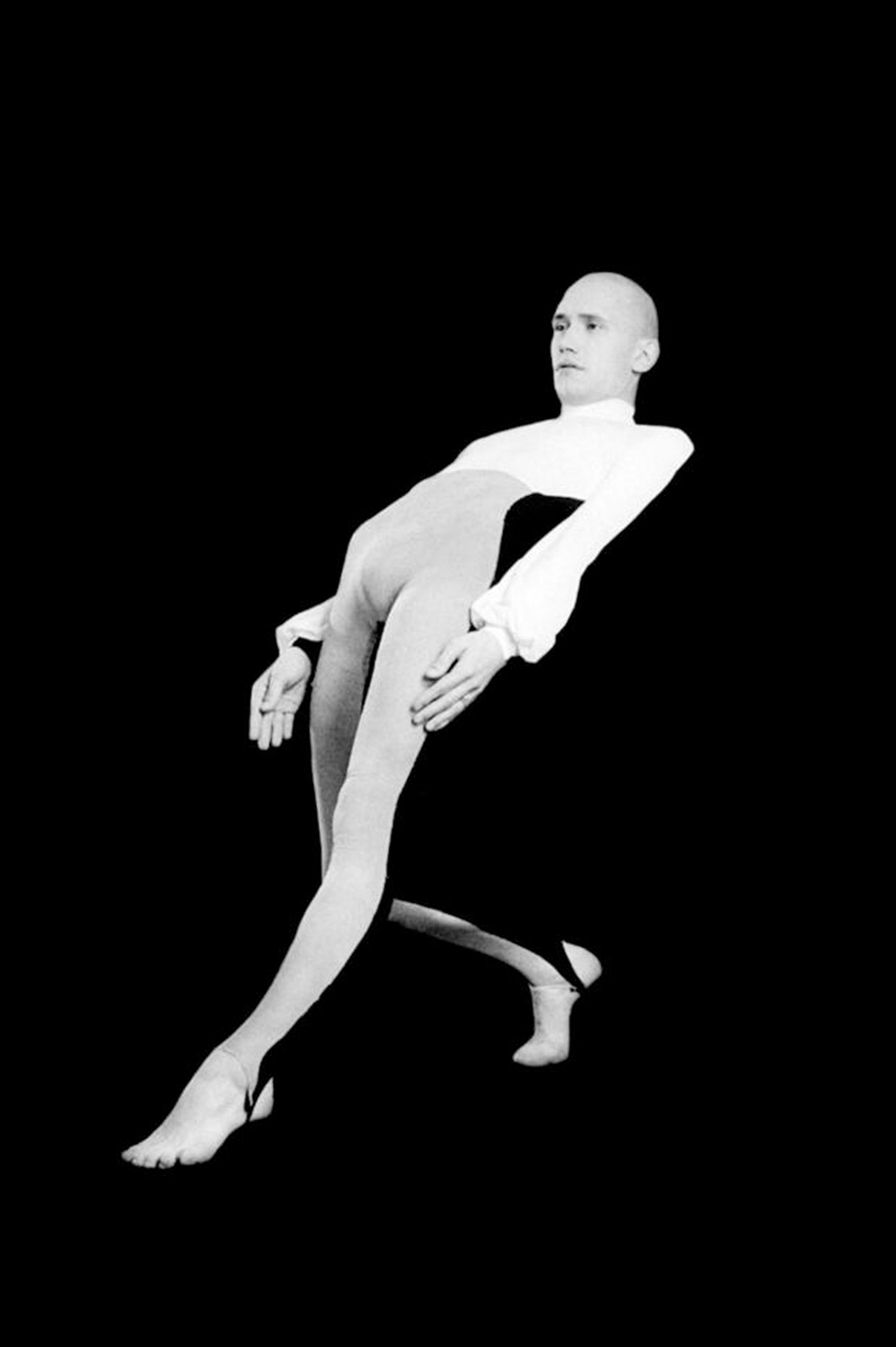Michael Clark
To celebrate our exhibition Michael Clark: Cosmic Dancer, writer Sarah Crompton looks backs at the career of dance legend Michael Clark, reflecting on his style and cult status.
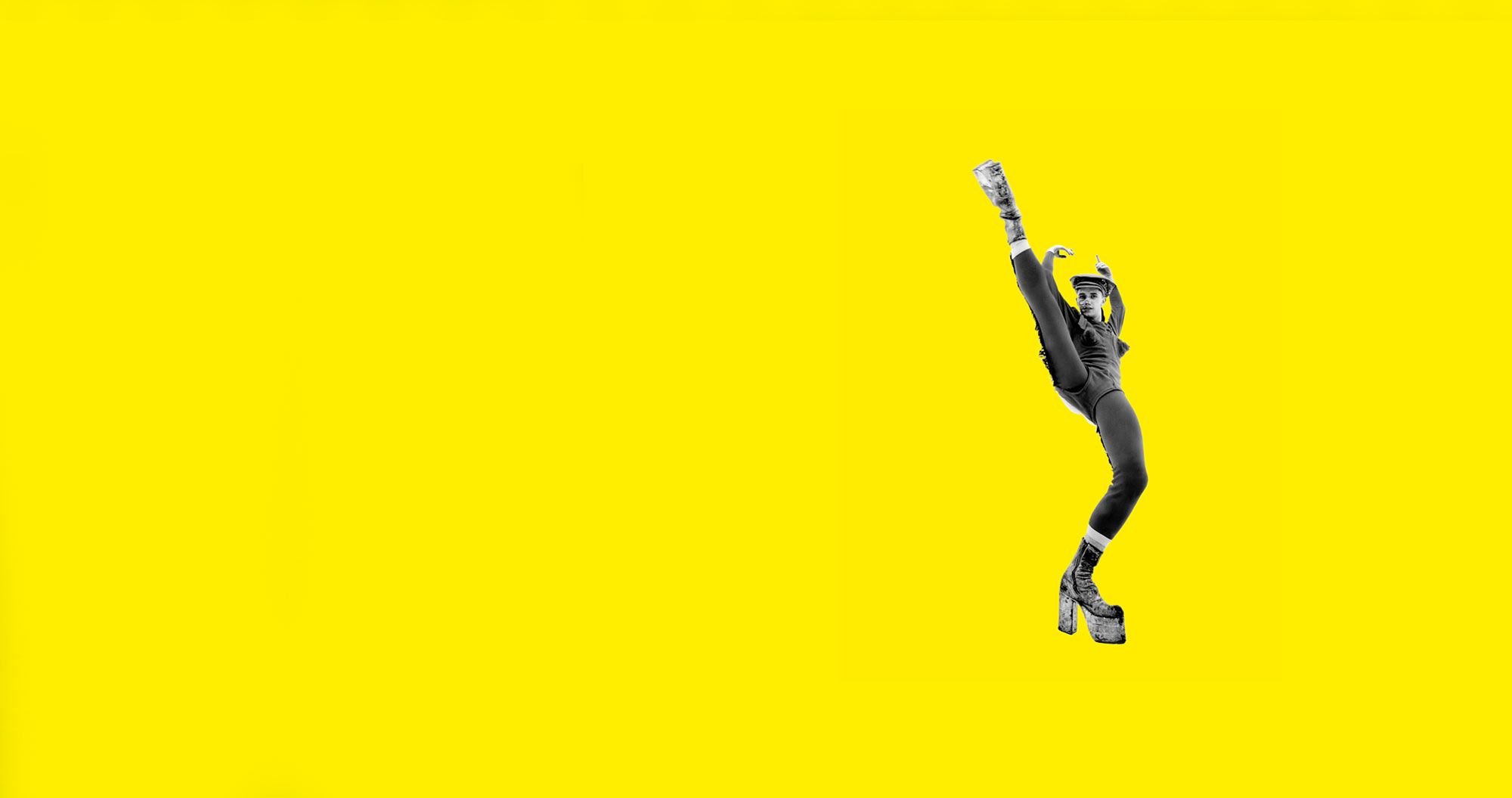
'From the start, dancing was always an escape from normality for me'
Michael Clark

Cosmic Dancer

The year was 1986, at the height of his first fame, the dancer and choreographer Michael Clark appeared on an Italian RAI TV show. Wearing a diaphanous yellow dress and black flared trousers, he dances to Marc Bolan’s Cosmic Dancer. You can see the performance on YouTube and it is a magical, shimmering thing.
It’s beautiful in itself, full of grace, with tiny movements of the hands that extend and change the line of his body, little shivers of the shoulders that respond precisely to the music. But what is most extraordinary is how, in the setting of a cheesy TV chat show, Clark changes the mood. The sheer perfection of his movement and the grave commitment of his performance introduce a note of seriousness to the glitz. His artistry alters the temperature of the room. Art arrives in a forum of entertainment, and Clark seems entirely comfortable in both places.
This is a tiny example of the many paradoxes at the heart of Clark’s work. His distinctive talent seems to walk a tightrope between opposites: the Apollonian concept of pure dance versus the Dionysian energy of excess; order versus chaos; logic versus intuition; discipline versus anarchy; control versus release; survival versus self-destruction. In the space between these contrasts he has carved an entirely original career.
Clark is always dubbed a bad boy, a rebel, a rule breaker. There’s a wonderful moment in Sophie Fiennes’s film The Late Michael Clark (2001) when a member of the audience at an after-show question and answer session asks him whether he is a dance anarchist. He pauses for a long time before someone suggests he simply say yes. I think he hesitates because the truth is rather more complex. It’s perhaps more accurate to see him as an outsider, someone who emerged from so far from ballet’s refined and rarefied world that he inevitably saw it differently. Jane Quinn, founding partner of Bolton & Quinn, who managed Clark’s company between 1984-9, observes:
'People have described Michael as an iconoclast. I don’t think this is right. He is quite simply a great artist of our time, who knows instinctively how to take his art, a construct of the 19th century, and twist it towards the present.'
Early Years

'I never really had a plan, except to express myself as purely as possible'
Michael Clark (2016)

Michael Clark was born in 1962 in rural Aberdeenshire, the youngest of five siblings growing up on a farm. He began dancing at the age of four, after nagging to join his older sister’s Scottish dancing lessons. 'From the start, dancing was always an escape from normality for me,' he told Sean O’Hagan in the Observer in 2016. 'And I took to it. Even though, at the very start, I found it very boring…I somehow stuck at it while the few other boys would come and go.'
In 1975, his talent was spotted, and he was invited to join the Royal Ballet School in London. He was two years behind the other pupils in terms of his training and felt he didn’t fit in, but his exceptional ability was noticed and encouraged by the Royal Ballet’s founder Dame Ninette de Valois and the choreographer Frederick Ashton. His teacher Richard Glasstone, who became a friend and ally, remembers: 'He was a beautiful sleek boy, wonderful footwork, nimble, an amazing Scottish dancer.'
In fifth form, he discovered punk.
That, as Glasstone wryly remarks, 'was the beginning of the end – or the beginning of the beginning!' Clark began bunking off school to see bands, and got caught with some other boys, sniffing glue and drinking. But the school didn’t throw him out – because, he claims, he had already been cast as the lead in the end of year performance.
It wasn’t the discipline Clark rebelled against. He loved that. But his mind was already working in new directions that didn’t conform to the constrictions of ballet at the time. His curiosity could not be satisfied by a traditional ballet training which discouraged other pursuits. 'I had to find a way of bringing together what I had learned, with all this other stuff that was much more exciting to me – punk and post-punk. People think I arrived from nowhere, but it actually took some time for things to come together.'
That coming together was underpinned by an exploration of different dance forms and techniques. After graduation in 1979, Clark joined Rambert (then Ballet Rambert) where he worked principally with Richard Alston. A summer school with choreographer Merce Cunningham and composer John Cage led to a stint in New York, working with Karole Armitage, and through her he met the film-maker and lighting designer Charles Atlas, who has worked on his productions ever since. He studied hard, learning about other American contemporary dance makers such as Yvonne Rainer and Trisha Brown. But his own punk sensibilities, and his liking for the kind of theatrical expressiveness of costume and dressing-up represented by his friend, the performance artist and club icon Leigh Bowery, made him want to collide the austerity of classical and contemporary dance with something quite different.
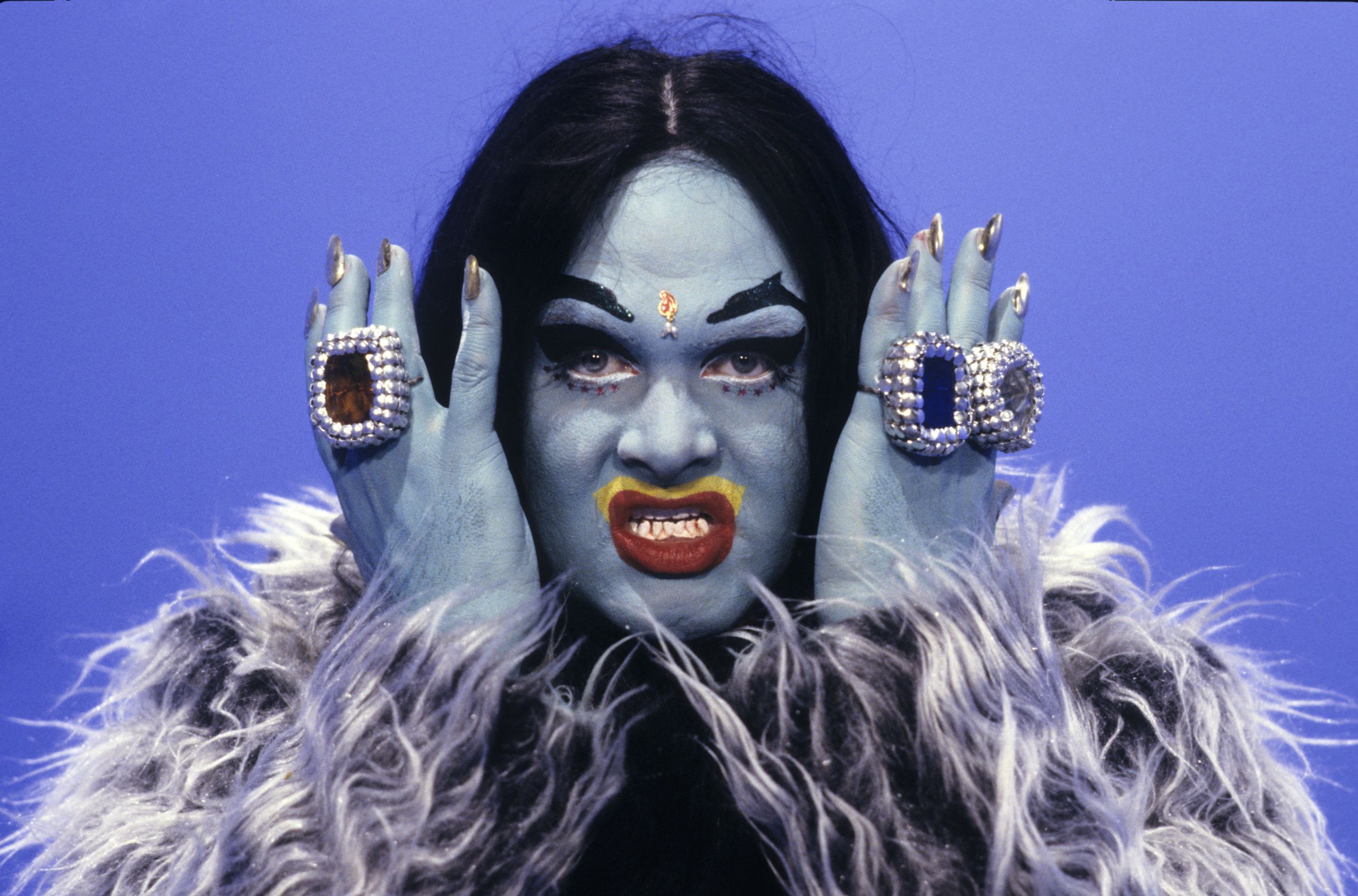
Leigh Bowery during the filming of Charles Atlas, Because We Must, 1989.© Dee Conway / Bridgeman Images
Leigh Bowery during the filming of Charles Atlas, Because We Must, 1989.© Dee Conway / Bridgeman Images
'I was reacting to a particular dance ethos – which had always seemed to mean saying no to spectacle, to comedy or narrative, no to virtuosity,' he told Adrian Searle in the Guardian in 2001. 'I wanted to say yes to all those things, to acknowledge those elements as part of the visual aspect of dance, which has to include how people are dressed.'
Early Work

Text over media
'People don’t see beyond the princes and swans. I wanted to make something that was more relevant to everyone'
Michael Clark, 2018

The early 1980s was one of those rare periods when there was truly British avant-garde, a moment when new ideas about art, society and politics came together with a burgeoning underground club culture to create intense, unsettling creative ferment. Michael Clark was at its heart.
In 1982, David Gothard invited him to become choreographer in residence at the Riverside Studios in West London (a former TV studio where old episodes of Doctor Who had been filmed) which had become a hotbed for these new ideas with a group of artists in residence that included Bruce McLean and Will Alsop. Clark lived and worked there, magnetically growing a circle of innovators into his ambit, including Bowery, and the artist Cerith Wyn Evans, a protégé of Derek Jarman.
By 1984, when he launched his own company, he had made 16 original pieces – a staggering number for a 22-year-old – collaborating with fashion designers David Holah and Stevie Stewart of Bodymap, and musicians including The Fall, Wire, as well as Laibach (hardcore Slovenians) in 1986. In working with artists and musicians, he attracted a new audience for dance: young, hip, more in love with fashion and music than contemporary dance and ballet. He also built a group of friends, whose loyalty to him has never wavered down the years. He was a perfectionist, serious about his art, throwing down a gauntlet, challenging audiences with something new, but he was also a young man, having fun with his mates.
The mood of the time is caught in another film on YouTube where Clark and his dancers appear with The Fall on the BBC’s late-night music show 'The Old Grey Whistle Test'. He dances with characteristic insouciant precision, with his bottom poking out through his Bowie red tights, a Bowery-designed cap perched jauntily on his head. It seems effortlessly ground-breaking, a moment when ballet suddenly becomes the language of the general culture.
'Nobody in dance today is reflecting the culture in the way that Michael did in the 1980s and 90s,' remarked the critic Jann Parry in 2018.
His instinct was to bridge the gap between the etiolated world of dance, which he respected, and the more extravagant, energetic world in which he lived, by simply bringing them together. The works that he produced from this time until the end of the decade, such as No Fire Escape In Hell, and I Am Curious, Orange generated the excitement of rock gigs.
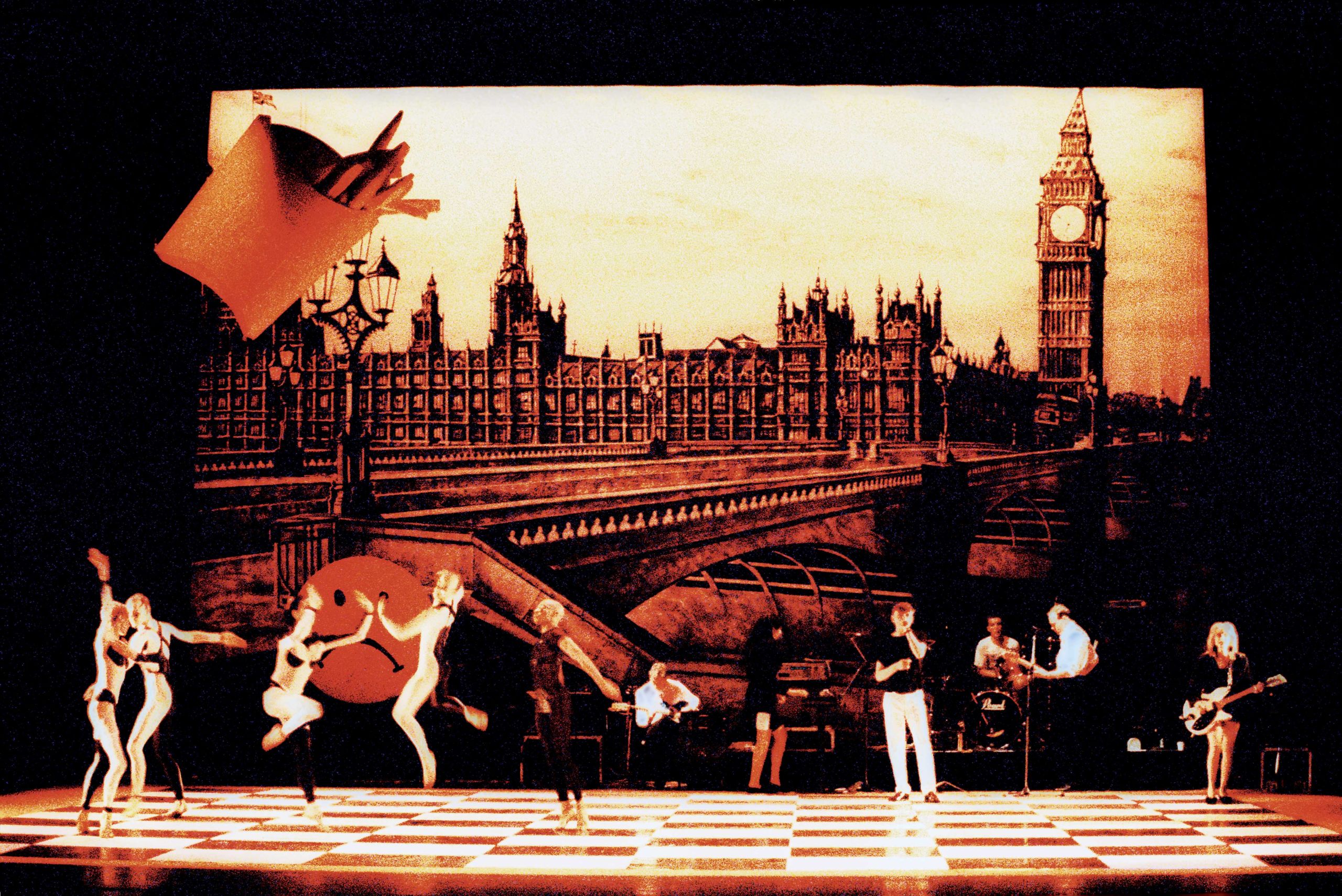
Michael Clark & Company with The Fall in I
Am Curious, Orange, 1988
Sadler’s Wells Theatre, London
© Richard Haughton
Michael Clark & Company with The Fall in I
Am Curious, Orange, 1988
Sadler’s Wells Theatre, London
© Richard Haughton
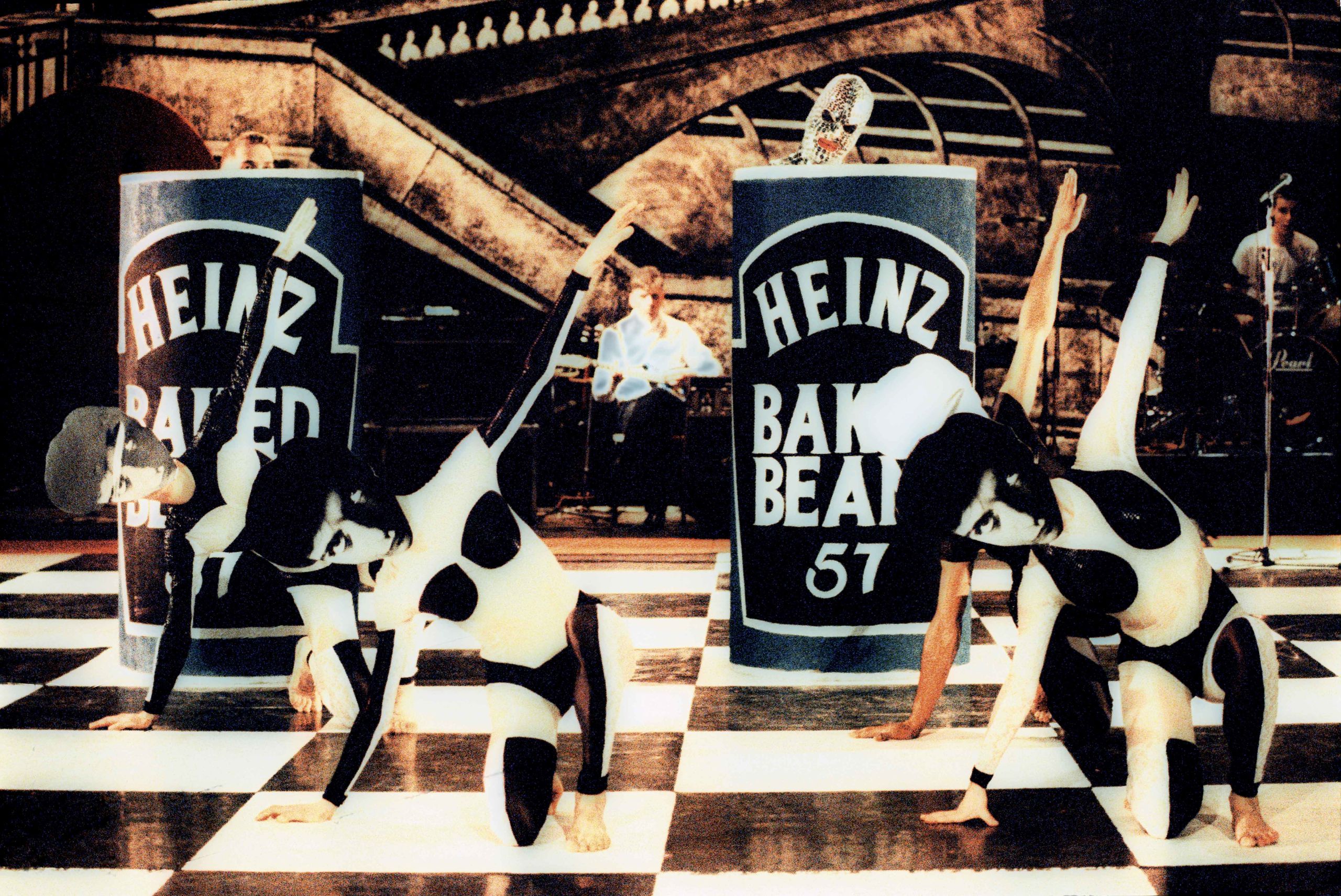
Michael Clark & Company with The Fall in I
Am Curious, Orange, 1988
Sadler’s Wells Theatre, London
© Richard Haughton
Michael Clark & Company with The Fall in I
Am Curious, Orange, 1988
Sadler’s Wells Theatre, London
© Richard Haughton
But for all the exuberant hedonism, the large prosthetic dildos, the elaborate costumes, the pounding scores, Clark’s choreographic power sprang from the structure he introduced. 'I always thought dance was about tidying up,' he told Searle in 2001. 'What I do is as messy as everything else, but you have to have a level of structure…You might fall on your face, but you also have to know how to sustain an evening’s performance.'
Charles Atlas made two films – Hail the New Puritan (1986) and Because We Must (1989) which encapsulate Clark’s work at this time. Hail the New Puritan begins with challenge – 'I can’t do a Bluebird, but wait till you see my fishdive' – and pivots on exactly that opposition: we see Clark at work in the studio, leading his dancers in sharp, tilting lines of movement, with quick feet and off-balance turns. We also see him in a club, urging on the dancefloor. In between, you see the work he is producing: innovative, daring, a blending of the worlds.
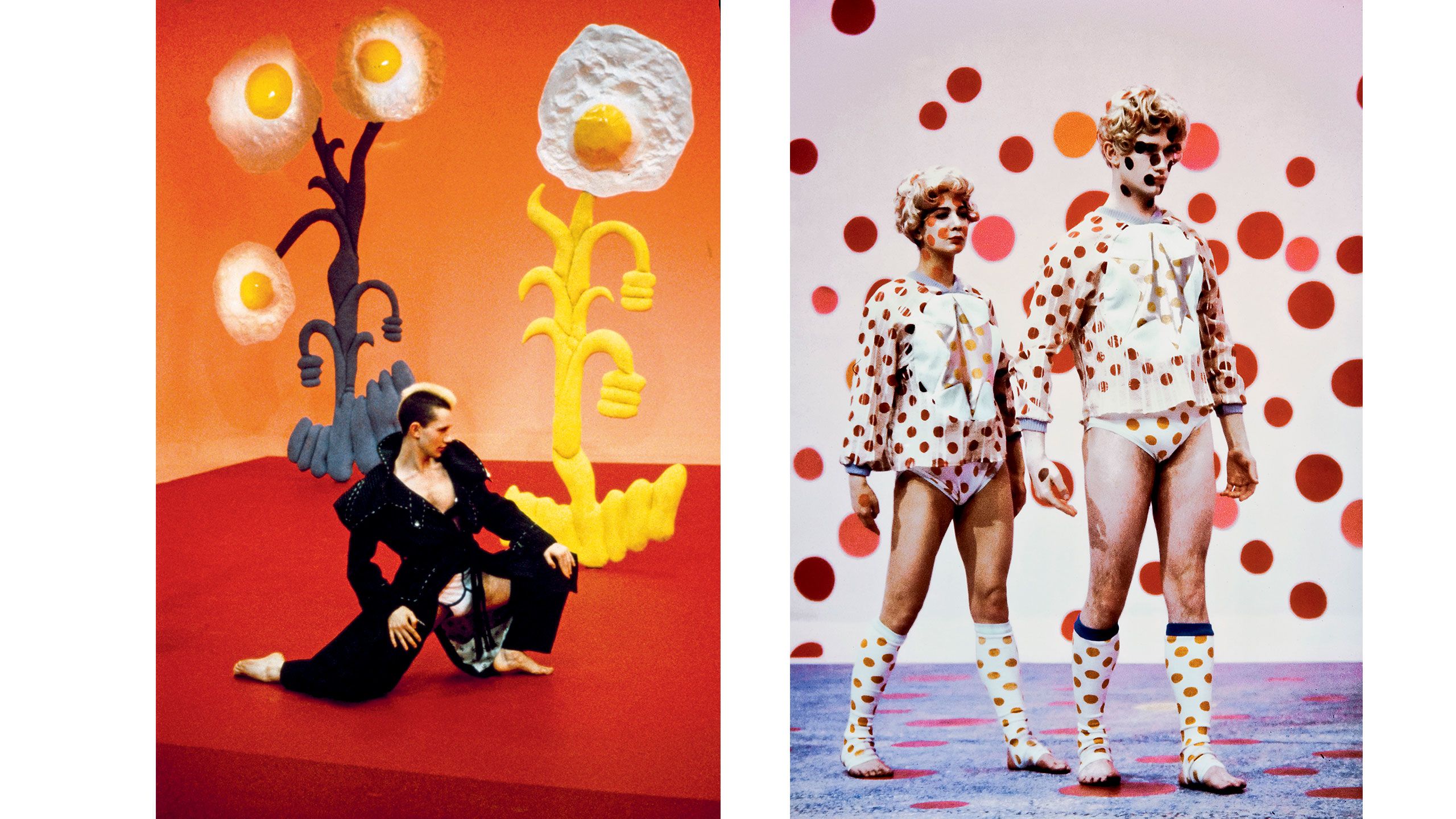
Left: Michael Clark during the filming of Charles Atlas’s Hail the New Puritan, 1986 © Alexander James. Right: Ellen van Schuylenburch and Michael Clark during the filming of Charles Atlas’s Hail the New Puritan, 1986 © Richard Haughton
Left: Michael Clark during the filming of Charles Atlas’s Hail the New Puritan, 1986 © Alexander James. Right: Ellen van Schuylenburch and Michael Clark during the filming of Charles Atlas’s Hail the New Puritan, 1986 © Richard Haughton
The Middle Period

'I didn’t realise it would last ten years'
Michael Clark, on addiction

By the early 1990s, Clark was a superstar. Andy Warhol came to watch his company perform in New York and waited afterwards to escort him and Bowery to a gig; in Paris, he had dinner with Rudolf Nureyev, Margot Fonteyn and Jackie Onassis. 'She let me try on her coat.' He was working ferociously hard, not only creating work for his own company, but for others including the Paris Opera Ballet, London Festival Ballet, Rambert and Deutsche Oper, Berlin. In 1991, he choreographed and danced the role of Caliban in Peter Greenaway’s Prospero’s Books, working in miserable, difficult conditions.
His works, which toured widely at that time, continued to break new ground, both in subject matter, design and quite literally, since his inclination was to perform outside theatres rather than within them. In Heterospective (1989), the Antony d’Offay gallery was the setting for a performance that began when Clark and his then-lover the American choreographer Stephen Petronio had finished having sex beneath the covers of a bed. Clark later danced a solo to Velvet Underground’s Heroin, in a flesh-coloured body suit, punctured with syringes.
Mmm... (1992), his version of Stravinsky’s The Rite of Spring incorporated music from the Sex Pistols and Stephen Sondheim and featured his much-loved mother Bessie giving birth to him on stage, while Bowery acted as midwife. In London, it was performed at King’s Cross Depot, with excitable queues forming outside; Clark at one point, performed wearing a toilet seat as a headdress. O from 1994, another work inspired by Stravinsky (this time by the score for Apollo), was performed at the Brixton Academy and featured another agonised birth.
The workload took its toll. Clark has always said that he began taking heroin 'to discover physical addiction' but Sophie Fiennes believes that the pressure of keeping a company afloat also took its toll. 'It seemed somewhere between a creative experiment and a way to avoid the burdens of running an independent dance company, which he had done since a very early age,' she says.
Whatever the reason, in 1994, Clark withdrew from a Royal Ballet commission and sought refuge in his mother’s home – where he remained for the next four years. 'When I eventually came off methadone, which was a prolonged and hard process, I moved to alcohol,' he told Sean O’Hagan. Fiennes was on hand to film his emergence, clean and smiling but still fragile, in her film The Late Michael Clark (2001), which opens with the answer phone messages left by his friends, trying to get hold of him.
Fiennes also records his return to the stage in 1998 with current/SEE, a piece that combined the throbbing hyper-amplified sound of five bass guitars (courtesy of Big Bottom, a band formed by Susan Stenger) with costume design from Hussein Chalayan. Clark’s teacher Richard Glasstone had been instrumental in his recovery, working with him on the refined geometries and rapid movements of the Cecchetti technique. In current/SEE the upright delicacy of that style is combined with a work on the floor, with the dancers seeming to carve sculpture out of the air.
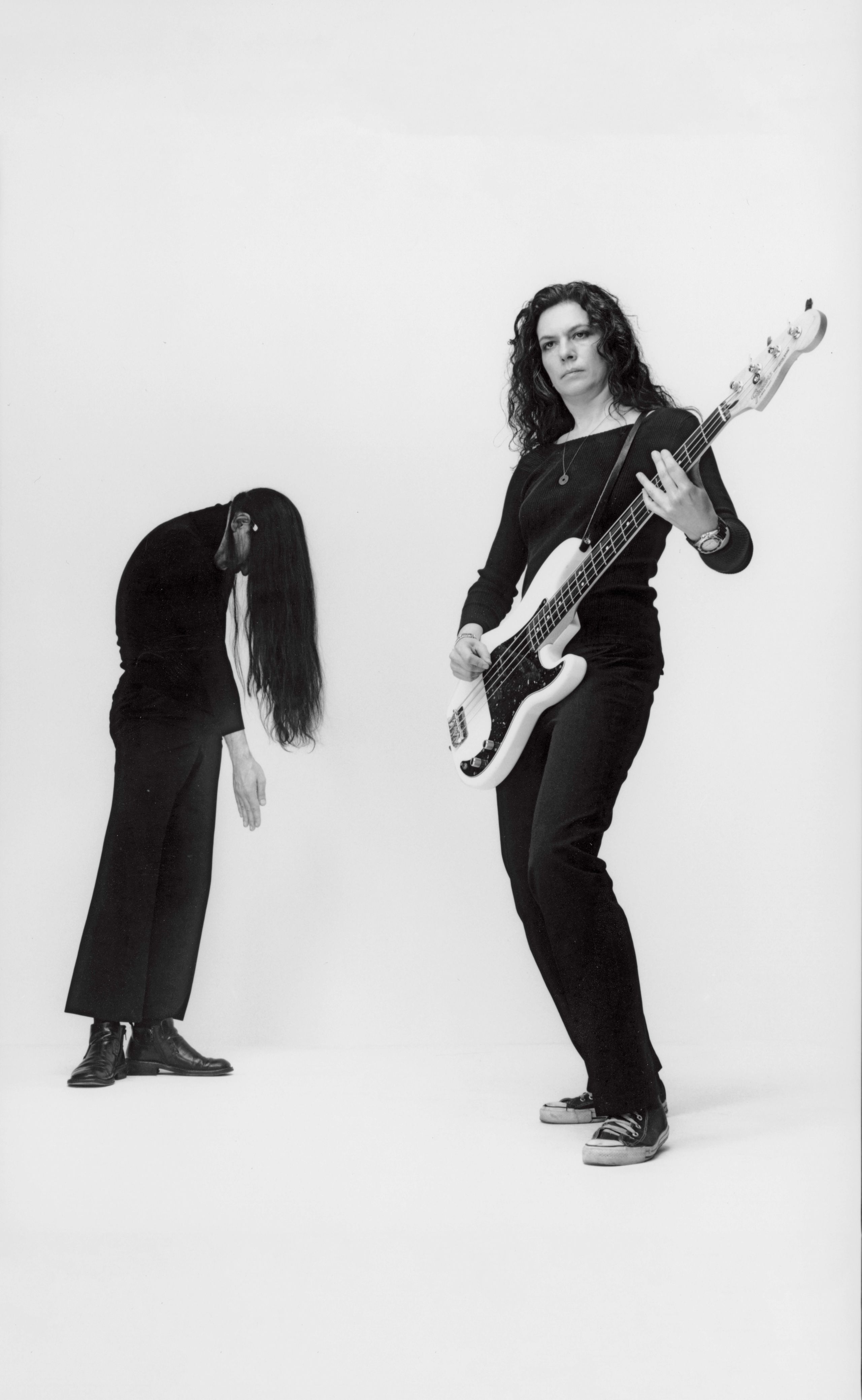
Michael Clark and Susan Stenger in a publicity photograph for current/SEE, 1998. © Hugo Glendinning
Michael Clark and Susan Stenger in a publicity photograph for current/SEE, 1998. © Hugo Glendinning
In an audience question and answer session recorded in Blackpool at that time, Clark explained what inspired him to keep making dance.
'I love words and I love the complexity of words, but I guess I’m more interested in what I consider a more complex place, which is where things can’t be made specific through language. More often than not, things which try to have an obvious meaning or try to communicate one thing, don’t really interest me.'
This is one part of what continues to make Clark’s vision so important. Another is his trail-blazing instinct that somehow his work was as much (or even more) visual art than contemporary dance. He made friends with artists and collaborated with them, for example in Before and After: The Fall (2001), a piece dominated by Sarah Lucas’s enormous, mechanical masturbating arm. ('It’s been no end of a headache. It looks good but we can never get it to do what it’s supposed to,' she said in an interview at the time.) Some critics objected that such 'gimmicks' distracted from the intricacy of the choreography and the beauty of the dancing. Clark has always been clear: 'I am …interested in working with designers and composers who [have] strong ideas of their own and people who challenge me as much as I did them.'
The Barbican Years

Text over media
'I’m not running away from something. I’m constantly going somewhere on a journey I can’t imagine stopping.'
Michael Clark, 2018

The second half of Michael Clark’s brilliant career has been as eventful and creative as the early half. But it has perhaps been quieter; his talent has been turned to burnishing and deepening his choreographic invention rather than exploding outwards into sensational happenings. The high-profile gollaborations have been there – two works for Mikhail Baryshnikov, the choreography for Alexander McQueen’s 2003 Spring/Summer collection, for example – but his main focus has been on work for his company.
Since 2005, that company has had its base at the Barbican, where Clark is an Artistic Associate, giving it a security that is rare for independent dance companies. Even so, in 2006 its financial position was so perilous that friends in the art world including the gallerist Sadie Coles, and artists Sarah Lucas, Damien Hirst, Anish Kapoor and Tracey Emin rallied round to donate works to an auction at Christie’s to help keep it afloat.
The continuity and resources offered by the Barbican initially allowed Clark to rethink and complete his long-cherished Stravinsky Project (2005-2007), adding a new work I Do (using the score for Les Noces) to remounted versions of Mmm... and O. Some of the mad excitement of the earlier productions might have vanished, but none of the creativity. The three works – performed with live music – revealed Clark’s mastery of his material as the fierce patterns of his complex choreography rose to the challenge of these famous ballet scores.

Michael Clark Company in Mmm..., 2006 Barbican Theatre, London. © Hugo Glendinning
Michael Clark Company in Mmm..., 2006 Barbican Theatre, London. © Hugo Glendinning
At the start of his career, when asked why he worked with rock music, he would explain that he felt complex, classical music dictated too much to him.
'I enjoy the simplicity of… The Fall because it gives me a sort of broader canvas to make whatever I want on to,' he said in 1986.
According to an essay by Stephanie Jordan on The Stravinsky Project, the pounding beat gave him freedom: sometimes to follow them, sometimes to work in the gaps between them. When it came to Stravinsky, however, he became immersed in the scores because it was simply 'incredible, some of the best dance music I have ever heard.' The very complexity of the scores, their elaborate timings put him into a completely different relationship to making work; what was astonishing was the way that the almost mathematical precision of his choreography flourished in this new setting.
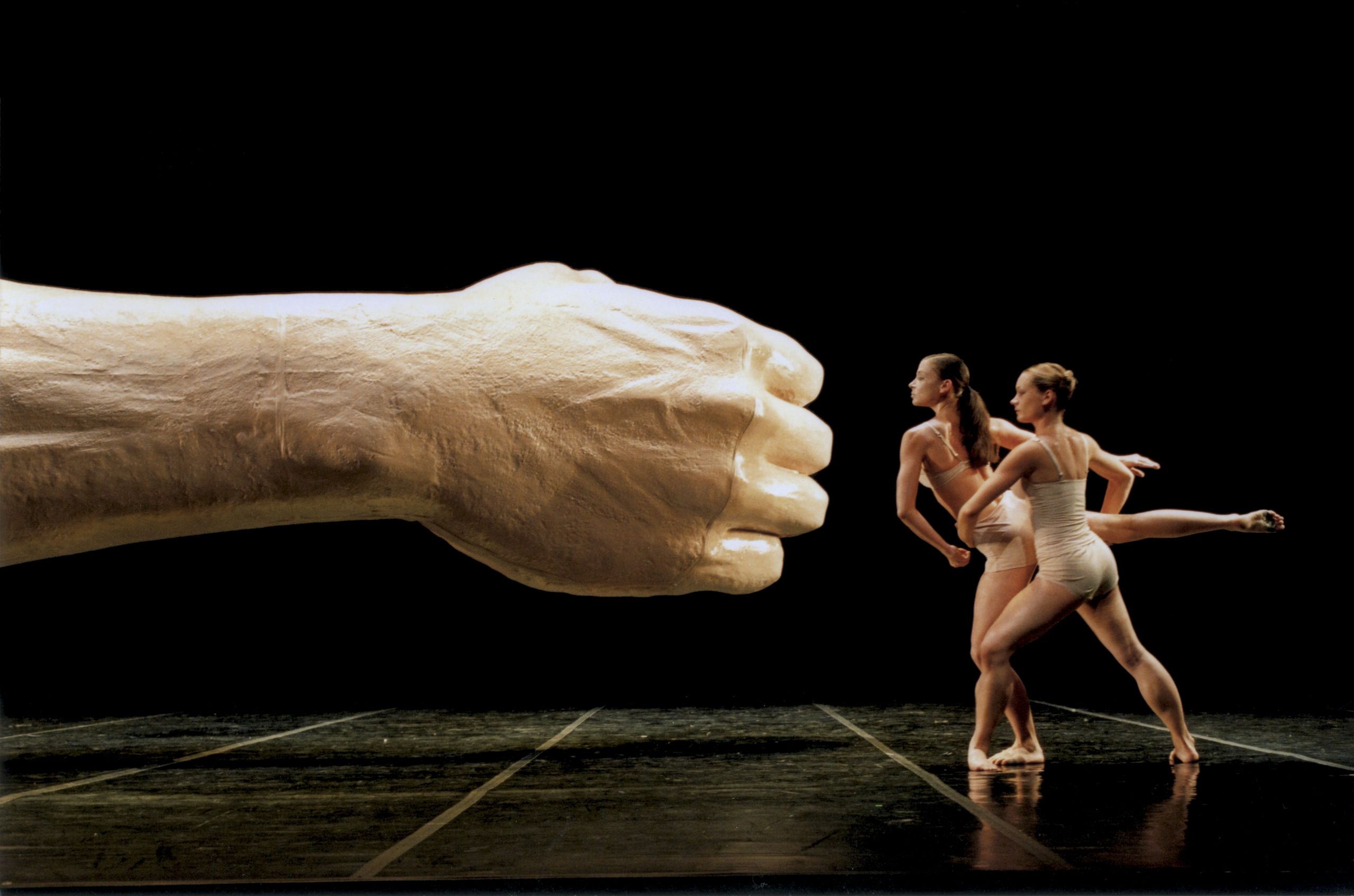
Lorena Randi and Victoria Insole in Before
and After: The Fall, 2001
Hebbel-Theater, Berlin.
© Andrea Stappert
Lorena Randi and Victoria Insole in Before
and After: The Fall, 2001
Hebbel-Theater, Berlin.
© Andrea Stappert
Indeed, the consistency of his choreographic invention continues to be the sustaining power of his work. There’s something in it that seems to evoke the kind of balances and oppositions that are inherent in his life and career, it is constantly poised on the edge of something, exploring shape and movement through space and time. It has changed down the years – he has jettisoned the elaborate costumes in order for the dance to be seen more clearly - but its essential exploratory, probing quality remains.
In 2009, Clark celebrated 25 years of his company with come, been and gone, a work that expressly examined his past, giving Kate Coyne a solo to Heroin in a costume covered in fake syringes – like the one he had worn more than a decade previously. The piece, to a glorious soundtrack of 1970s rock, was celebratory and playful, full of references to previous work, but triumphantly blazoning forth a hopeful future with new styles and ideas. It featured large helpings of David Bowie, a presiding genius in both Clark’s life and work. 'The moment when he put his arm around Mick Ronson on Top of the Pops all those years ago in the 1970s…triggered this huge sense of relief in me as a boy. It was the only physical contact I had seen men do apart from punching each other. It seems ridiculous now that a small gesture like that could be so meaningful, but, for me, it was. It planted in me the idea that there was another way.'
Bowie featured again, along with Pulp and Kraftwerk, in the soundtrack of rousing yet contemplative pop that accompanied a new work in 2011 in the Turbine Hall at Tate Modern. A troupe of 50 amateur dancers swelled numbers and filled the huge space with the impact of their sculptural lines set against a stark, monochrome design. Clark himself appeared, briefly, huddled in foetal patterns beneath a film of Bowie singing Heroes.
Clark made a cameo appearance too, in to a simple rock'n'roll…song, his most recent piece, a triptych of abstract dances opening with the music of Eric Satie and concluding again with Bowie, this time in the valedictory Blackstar. 'Clark has always been a huge talent,' wrote Debra Craine in her review in The Times. 'But here his artistry reaches a zenith in which being chic and being smart are allied to a real passion for pure dance.'

Oxana Panchenko and Clair Thomas in a publicity photograph for come, been and gone, 2009. © Jake Walters
Oxana Panchenko and Clair Thomas in a publicity photograph for come, been and gone, 2009. © Jake Walters
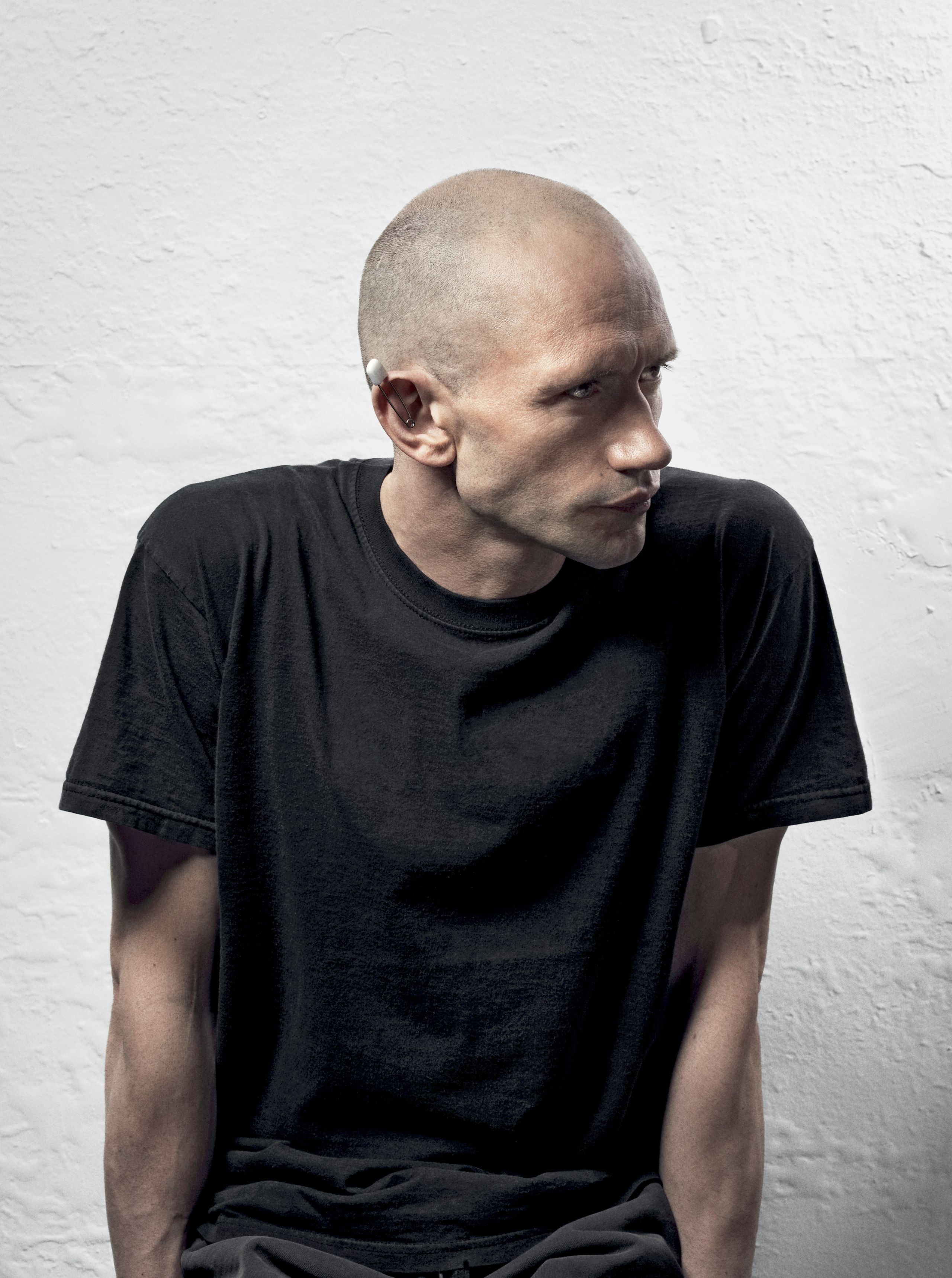
Michael Clark © Jake Walters
Michael Clark © Jake Walters
That’s the thread that has run through Clark’s entire career. 'Most people who think they’re leaving classical ballet tend to reject it completely,' he told Ismene Brown in 2004. 'I quickly realised that it was very much part of me.' But it is what he has made of it, that has made his journey such a compelling one. No-one has taken ballet further from its historic origins while remaining so true to its classical principles. He is a true original.
Listen to our Spotify playlist that accompanies the exhibition
About Michael Clark: Cosmic Dancer
The first major exhibition of dancer and choreographer Michael Clark. This exploration of Clark’s work establishes his radical presence in British cultural history.
New works include Charles Atlas revisiting the acclaimed Hail the New Puritan (1986), which featured Leigh Bowery and The Fall, as an immersive film installation, along with work by Sarah Lucas, Wolfgang Tillmans, Cerith Wyn Evans, Peter Doig, Silke Otto-Knapp, Duncan Campbell and more.
The exhibition takes place from 7 Oct 2020–3 Jan 2021 in the Barbican Art Gallery.
About Sarah Crompton
Sarah Crompton is one of Britain’s leading culture writers and broadcasters, commentating on all aspects of the arts. Her work appears in the Guardian, the Sunday Times, The Times, the Observer, British and American Vogue among others. She reviews theatre for Whatsonstage and dance for the Observer. She is a regular contributor to the BBC’s Front Row and Saturday Review. She was previously the Arts Editor in Chief and dance critic of the Daily Telegraph, and a contributor to BBC2’s The Review Show. Her first book was Sadler’s Wells: Dance House, a study of the recent creative history of Sadler’s Wells.
Photo: Michael Clark in publicity photograph for Mmm…1992 © Hugo Glendinning
